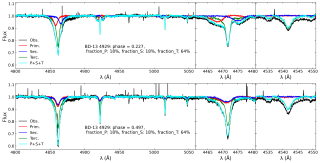We find a distinct stellar population in the counterrotating and kinematically decoupled core of the isolated massive elliptical galaxy NGC 1700. Coinciding with the edge of this core, we find a significant change in the slope of the gradient of various representative absorption line indices. Our age estimate for this core is markedly younger than the main body of the galaxy. We find lower values for the age, metallicity, and Mg/Fe abundance ratio in the center of this galaxy when we compare them with other isolated elliptical galaxies with similar velocity dispersion. We discuss the different possible scenarios that might have lead to the formation of this younger kinematically decoupled structure and conclude that, in light of our findings, the ingestion of a small stellar companion on a retrograde orbit is the most favored.
Advertised on
References
2011, ApJ, 732L, 33K
It may interest you
-
 The most massive stars in the universe are often born and evolve in binary and multiple systems — that is, in pairs or groups bound by their mutual gravity. Understanding how they interact with each other is key to explaining everything from their formation to the impact they have on the galaxies they inhabit. The MONOS project (Multiplicity Of Northern O-type Spectroscopic systems) aims to study these systems in the northern sky, combining spectroscopic observations (which analyze light split into its component colors to measure stellar velocities and physical properties) with photometryAdvertised on
The most massive stars in the universe are often born and evolve in binary and multiple systems — that is, in pairs or groups bound by their mutual gravity. Understanding how they interact with each other is key to explaining everything from their formation to the impact they have on the galaxies they inhabit. The MONOS project (Multiplicity Of Northern O-type Spectroscopic systems) aims to study these systems in the northern sky, combining spectroscopic observations (which analyze light split into its component colors to measure stellar velocities and physical properties) with photometryAdvertised on -
 The existence of dark matter is probably one of the fundamental mysteries of modern science and unraveling its nature has become one of the primary goals of modern Physics. Despite representing 85% of all matter in the Universe, we do not know what it is. In its simplest description, it is made up of particles that interact with each other and with ordinary matter only through gravity. However, this description does not correspond to any physical model. Finding out what dark matter is requires finding evidence of some kind of interaction of dark matter that goes beyond gravity. In our workAdvertised on
The existence of dark matter is probably one of the fundamental mysteries of modern science and unraveling its nature has become one of the primary goals of modern Physics. Despite representing 85% of all matter in the Universe, we do not know what it is. In its simplest description, it is made up of particles that interact with each other and with ordinary matter only through gravity. However, this description does not correspond to any physical model. Finding out what dark matter is requires finding evidence of some kind of interaction of dark matter that goes beyond gravity. In our workAdvertised on -
 WISEA J181006.18-101000.5 (WISE1810) is the nearest metal-poor ultracool dwarf to the Sun. It has a low effective temperature and has been classified as an extreme early-T subdwarf. However, methane--the characteristic molecule of the spectral class T--was not detected in the previous low-resolution spectrum. Constraining the metallicity--the abundance of elements heavier than helium-- of these cold objects has been a challenge. Using the 10.4 m Gran Telescopio Canarias, the largest optical-infrared telescope in the world, we collected a high-quality near-infrared intermediate-resolutionAdvertised on
WISEA J181006.18-101000.5 (WISE1810) is the nearest metal-poor ultracool dwarf to the Sun. It has a low effective temperature and has been classified as an extreme early-T subdwarf. However, methane--the characteristic molecule of the spectral class T--was not detected in the previous low-resolution spectrum. Constraining the metallicity--the abundance of elements heavier than helium-- of these cold objects has been a challenge. Using the 10.4 m Gran Telescopio Canarias, the largest optical-infrared telescope in the world, we collected a high-quality near-infrared intermediate-resolutionAdvertised on